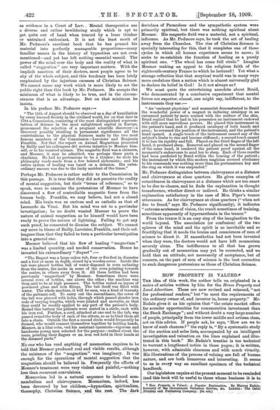HOW PROPERTY IS VALUED.*
Tun idea. of this work, the author tells us, originated in a series of articles written by him for the House Property and Land Advertiser. These are now revised and reissued, "not for professional readers," but "to meet the requirements of the ordinary owner of, and investor in, house property." Mr. Esdale gives it as his opinion that "the estate market offers far sounder opportunities for remunerative investment than the Stock Exchange "; and without doubt a very large number of people, principally from the lower middle and artisan class, act on this advice. If people ask, he says, " How are we to know of such chances ? " the reply is, " By a systematic study of the auction and sales lists, accompanied by an intelligent investigation and valuation on the lines explained and illus- trated in this book." Mr. Esdale's treatise is too technical to warrant a lengthened notice in these pages; it is written, however, with admirable clearness and with much vivacity. His illustrations of the process of valuing are full of human nature, and are both, humorous and interesting. It seems to us in every way an excellent specimen- of the technical Handbook,
Our legislators require at the present moment to be reminded (and this book will be useful to those whose business it is to
S How Property is Valued: .a Popular Explanation, By Manua Eadale, fOrmerlY of me Govenument Valuation Service, &c. London : The Cable j'zi.3:431te aid Publishing Company, Leo. net.] see that they do not forget) that there is such a thing as the property market, in which for many generations ground-rents and reversions, leaseholds and freeholds, have been keenly dealt in by persons who have invested their savings in this class of property. The so-called "unearned increment" has been discounted by bond-fide buyers and sellers to the most minute fraction cif its value.. As a question of title, these persons have as much right to consideration as aily other holders of property. The policy of long lecises, with reyereibn to the owner of the soil at the end of a term, may on other grounds be questionable, and it has been plausibly argued- that the enforcement of a contract of such duration (on the analogy of the limitation of testamentary powers of 'settle- ment) is beyond the legitimate sphere of government. If so, let us argue it out in the open. The policy of striking at a system of town building by confiscatory taxation is indefensible.
A perusal of Mr. Esdale's volume will remind us that, although a few families have retained the reversionary interests arising under contracts made by their ancestors, by far the larger number of such interests are not' hereditary possessions, but have been bought and sold in comparatively recent times. Among "Points of Importance" Mr. Esdale asks his readers to remember: "In the first place a reversion which is distant more than 60 years is not worth considering —its present value is practically nil." Grievances, it has often been noticed, have a way of getting cured,—by the time the outcry against them has risen to its greatest height.
The following may be given as an instance in point. " Most people," Mr. Esdale tells us—some of our readers may plead guilty to being in the minority-," have probably noticed that there are many more opportunities now of acquiring free- hold property than there were 25 or 30 years ago, and they may have wondered what was the reason. It is accounted for largely by the passing of the-Settled Land Act, 1882." Previously the tenant for life of a settled estate could not sell the freehold_ of any part of it. Under Lord Cairns's Aot, 'however; he can now do so, and " fore the last 25 years an' increasing amount of freehold land has been available for investment." Altogether, a very .opportune and interesting 'volume.











































 Previous page
Previous page